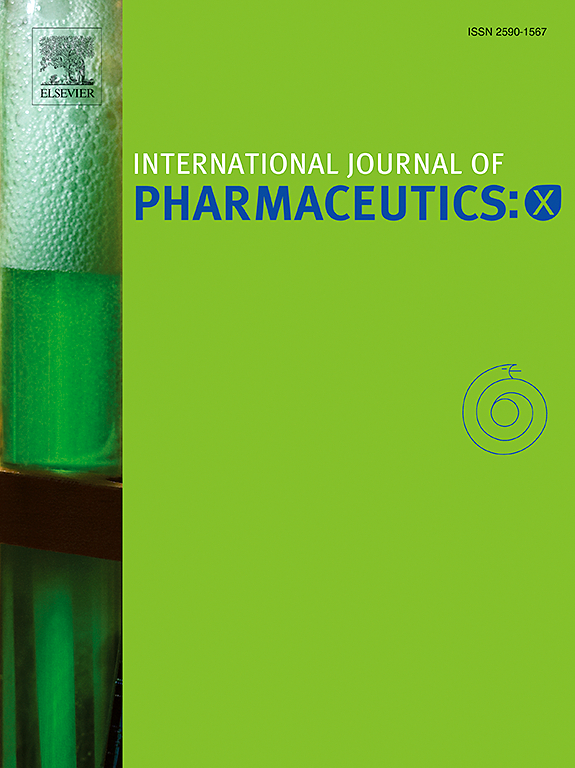Co-assembled Glycyrrhiza nanoparticles embedded supramolecular protein hydrogels to enhance licochalcone A release for acute inflammation management
IF 6.4
2区 医学
Q1 PHARMACOLOGY & PHARMACY
引用次数: 0
Abstract
Licochalcone A (LA) garnered remarkable acclaim in acute inflammation therapy, however, poor release capability from the matrix and oral bioavailability restrict its oral delivery. To address this challenge, licorice-derived glycyrrhizic acid (GA) and LA were co-assembled into GA-LA (GLA) binary co-assembled Glycyrrhiza nanoparticles (BCGNs), which were subsequently incorporated into supramolecular hydrogel matrix. GLA BCGNs demonstrated a remarkable capacity to scavenge various reactive oxygen species (ROS) and facilitated the cascade process of O2•−-H2O2-O2 in vitro. Subsequently, GLA was dispersed in nano form into ovalbumin (OVA) and rhamnose (Rha) solutions, which were next self-assembled into OVA-Rha-GLA hydrogels. Remarkably, the introduction of Rha induced disordered secondary conformation of OVA, which decreased its mechanical properties and inherent binding energy, thereby shaping the three-dimensional supramolecular spatial structures of OVA-Rha-GLA networks. The assembly mechanisms indicated that the hydrogen bonding predominantly drove the assembly of loose supramolecular networks surrounded by -OH, -CH2 and C![]() O bonds on the Rha and OVA. Notably, the conformational transformation facilitated faster LA release, confirmed by computational simulation analysis, which was conducive to acute inflammation curation. Therefore, OVA-Rha-GLA exhibited excellent anti-inflammation and ROS-scavenging versatilities, displaying improved oral bioavailability compared to hydrogels lacking BCGNs or Rha in cellular and animal acute inflammation experiments. The results provided novel BCGNs-embedded supramolecular hydrogel systems to improve the drug release and anti-inflammatory bioactivities of LA, which demonstrated great promise in the management of acute inflammation.
O bonds on the Rha and OVA. Notably, the conformational transformation facilitated faster LA release, confirmed by computational simulation analysis, which was conducive to acute inflammation curation. Therefore, OVA-Rha-GLA exhibited excellent anti-inflammation and ROS-scavenging versatilities, displaying improved oral bioavailability compared to hydrogels lacking BCGNs or Rha in cellular and animal acute inflammation experiments. The results provided novel BCGNs-embedded supramolecular hydrogel systems to improve the drug release and anti-inflammatory bioactivities of LA, which demonstrated great promise in the management of acute inflammation.

共组装的甘草酸纳米颗粒嵌入超分子蛋白水凝胶,以促进甘草查尔酮A的释放,用于急性炎症管理
Licochalcone A (LA)在急性炎症治疗中获得了显著的赞誉,然而,其较差的基质释放能力和口服生物利用度限制了其口服给药。为了解决这一挑战,我们将甘草衍生的甘草酸(GA)和LA共组装成GA-LA (GLA)二元共组装的甘草酸纳米粒子(BCGNs),随后将其纳入超分子水凝胶基质中。在体外实验中,GLA BCGNs具有清除多种活性氧(ROS)的能力,促进了O2•−-H2O2-O2的级联过程。随后,GLA以纳米形式分散到卵清蛋白(OVA)和鼠李糖(Rha)溶液中,然后自组装成OVA-Rha-GLA水凝胶。值得注意的是,Rha的引入引起了OVA的无序二级构象,降低了其力学性能和固有结合能,从而形成了OVA-Rha- gla网络的三维超分子空间结构。组装机制表明,氢键主要驱动Rha和OVA上由-OH、-CH2和CO键包围的松散超分子网络的组装。值得注意的是,计算模拟分析证实,构象转变促进了LA的更快释放,有利于急性炎症的缓解。因此,OVA-Rha-GLA在细胞和动物急性炎症实验中,与缺乏BCGNs或Rha的水凝胶相比,表现出优异的抗炎和清除ros的多功能性,具有更高的口服生物利用度。研究结果提供了一种新的bcgns嵌入超分子水凝胶体系,可以改善LA的药物释放和抗炎生物活性,在急性炎症的治疗中具有很大的前景。
本文章由计算机程序翻译,如有差异,请以英文原文为准。
求助全文
约1分钟内获得全文
求助全文
来源期刊

International Journal of Pharmaceutics: X
Pharmacology, Toxicology and Pharmaceutics-Pharmaceutical Science
CiteScore
6.60
自引率
0.00%
发文量
32
审稿时长
24 days
期刊介绍:
International Journal of Pharmaceutics: X offers authors with high-quality research who want to publish in a gold open access journal the opportunity to make their work immediately, permanently, and freely accessible.
International Journal of Pharmaceutics: X authors will pay an article publishing charge (APC), have a choice of license options, and retain copyright. Please check the APC here. The journal is indexed in SCOPUS, PUBMED, PMC and DOAJ.
The International Journal of Pharmaceutics is the second most cited journal in the "Pharmacy & Pharmacology" category out of 358 journals, being the true home for pharmaceutical scientists concerned with the physical, chemical and biological properties of devices and delivery systems for drugs, vaccines and biologicals, including their design, manufacture and evaluation. This includes evaluation of the properties of drugs, excipients such as surfactants and polymers and novel materials. The journal has special sections on pharmaceutical nanotechnology and personalized medicines, and publishes research papers, reviews, commentaries and letters to the editor as well as special issues.
 求助内容:
求助内容: 应助结果提醒方式:
应助结果提醒方式:


